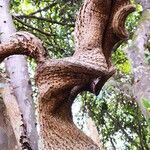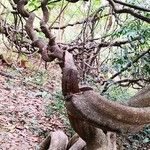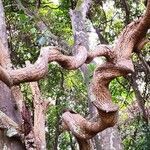Climbers, evergreen, large, woody. Stems often spirally twisted. Branches glabrous. Leaves 10-25 cm; petiole short; pinnae usually 2 pairs; leaflets 1 or 2 pairs, apical pair of pinnae transformed into a tendril, elliptic or narrowly obovate, 3-9 × 1.5-4.5 cm, leathery, base slightly oblique, apex obtuse, emarginate. Spikes 15-25 cm, solitary or arranged in a panicle, villous; bracts pubescent. Flowers slightly fragrant. Calyx campanulate, ca. 2 mm, 5-toothed. Petals 5, green with reddish base, oblong, ca. 4 mm, glabrous, slightly united at base, apex acute. Stamens white, slightly longer than corolla. Ovary glabrous; style filiform. Legume curved, flat, to 1 m × 8-12 cm, with a parchmentlike endocarp. Seeds dark brown, orbicular, flat, 4-6 cm in diam.; testa brown, brilliant, woody. Fl. Mar-Jun, fr. Aug-Nov. 2n = 28.
Woody climber, glabrous or infrequently puberulous. Pinnae 1-or 2-jugate. Leaflets 1-or 2-jugate, one of basal pair sometimes absent, ± inequilaterally elliptic, oval or obovate-elliptic; petiolules 0.5–3 mm long; lamina obtuse to acute, 4.5–10.5 cm long, 3–6 cm wide, shiny and drying darker on upper surface. Inflorescence spicate, solitary or several from a short shoot, to 30 cm long; bracteoles c. 1 mm long, deciduous. Flowers sessile, green with reddish base or dull purple, glabrous; calyx cupular, c. 1.5 mm long; petals c. 2.5 mm long. Pod compressed, straight to ± curved, to more than 1.25 m long, 5–15 cm wide, woody; innermost layer parchment-like. Seeds flattened, subcircular, 4–6 cm long, 3.5–5 cm wide, c. 1 cm thick, brown.
A tree climber which forms loops between branches. The stems are thick 12 cm across and irregularly round. They are twisted or have an irregular spiral. The small branches are slender. The leaves have long leaf stalks. The leaves are twice divided. The leaflets are 2.5 to 5 cm long and like leather. The flower stalk is 15 cm or more long. The flowers are 2 to 3 mm long and attached without a stalk. They are yellowish white. They are crowded on a long spike in the axils of leaves. The few pods hang down and the beans have flattened sides and are chocolate brown. They can be 1 m long. They are woody and jointed between the seeds.



